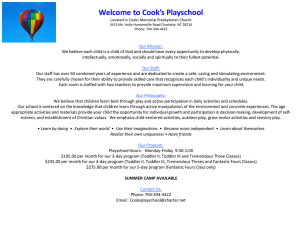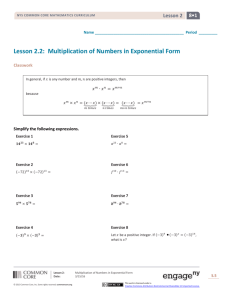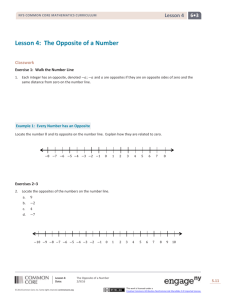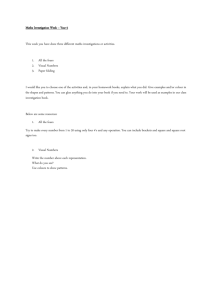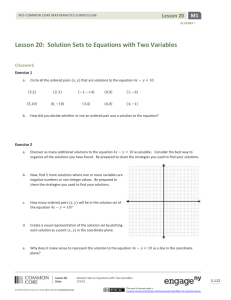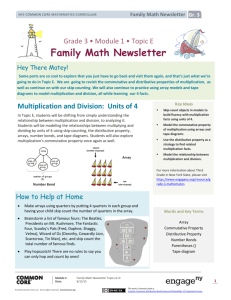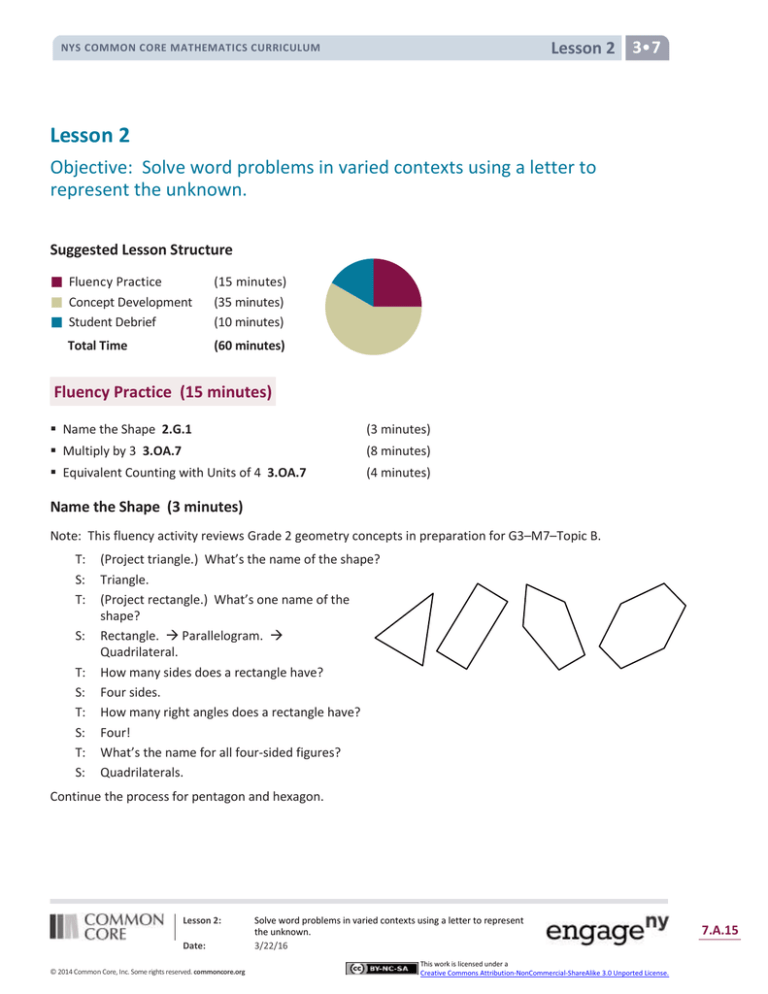
Lesson 2 3•7
NYS COMMON CORE MATHEMATICS CURRICULUM
Lesson 2
Objective: Solve word problems in varied contexts using a letter to
represent the unknown.
Suggested Lesson Structure
Fluency Practice
Concept Development
Student Debrief
Total Time
(15 minutes)
(35 minutes)
(10 minutes)
(60 minutes)
Fluency Practice (15 minutes)
Name the Shape 2.G.1
(3 minutes)
Multiply by 3 3.OA.7
(8 minutes)
Equivalent Counting with Units of 4 3.OA.7
(4 minutes)
Name the Shape (3 minutes)
Note: This fluency activity reviews Grade 2 geometry concepts in preparation for G3–M7–Topic B.
T:
S:
T:
S:
T:
S:
T:
S:
T:
S:
(Project triangle.) What’s the name of the shape?
Triangle.
(Project rectangle.) What’s one name of the
shape?
Rectangle. Parallelogram.
Quadrilateral.
How many sides does a rectangle have?
Four sides.
How many right angles does a rectangle have?
Four!
What’s the name for all four-sided figures?
Quadrilaterals.
Continue the process for pentagon and hexagon.
Lesson 2:
Date:
© 2014 Common Core, Inc. Some rights reserved. commoncore.org
Solve word problems in varied contexts using a letter to represent
the unknown.
3/22/16
This work is licensed under a
Creative Commons Attribution-NonCommercial-ShareAlike 3.0 Unported License.
7.A.15
Lesson 2 3•7
NYS COMMON CORE MATHEMATICS CURRICULUM
Multiply by 3 (8 minutes)
Materials: (S) Multiply by 3 Pattern Sheet (6–10)
Note: This activity builds fluency with multiplication facts using units of 3. It works toward students knowing
from memory all products of two one-digit numbers. See G3–M7–Lesson 1 for the directions for
administration of a Multiply By pattern sheet.
T:
S:
T:
S:
T:
S:
T:
S:
(Write 7 × 3 = ____.) Let’s skip-count up by threes. I’ll raise a finger for each three. (Count with
fingers to 7 as students count.)
3, 6, 9, 12, 15, 18, 21.
Let’s skip-count by threes starting at 15. Why is 15 a good place to start?
It’s a fact we already know, so we can use it to figure out a fact we don’t know.
(Count up with fingers as students say numbers.)
15 (5 fingers), 18 (6 fingers), 21 (7 fingers).
Let’s see how we can skip-count down to find the answer, too. Start at 30 with 10 fingers, 1 for each
three. (Count down with your fingers as students say numbers.)
30 (10 fingers), 27 (9 fingers), 24 (8 fingers), 21 (7 fingers).
Continue with the following suggested sequence: 9 × 3, 6 × 3, and 8 × 3.
T:
(Distribute Multiply by 3 Pattern Sheet.) Let’s practice multiplying by 3. Be sure to work left to right
across the page.
Equivalent Counting with Units of 4 (4 minutes)
Note: This activity builds fluency with multiplication facts using units of 4. The progression builds in
complexity. Work the students up to the highest level of complexity in which they can confidently
participate.
T:
S:
T:
S:
T:
S:
Count to 10. (Write as students count. See chart below.)
1, 2, 3, 4, 5, 6, 7, 8, 9, 10.
(Write 1 four beneath the 1.) Count to 10 fours. (Write as students count.)
1
2
3
4
5
6
7
8
9
10
1 four
2 fours
3 fours
4 fours
5 fours
6 fours
7 fours
8 fours
9 fours
10 fours
4
8
12
16
20
24
28
32
36
40
1 four
8
3 fours
16
5 fours
24
7 fours
32
9 fours
40
4
2 fours
12
4 fours
20
6 fours
28
8 fours
36
10 fours
1 four, 2 fours, 3 fours, 4 fours, 5 fours, 6 fours, 7 fours, 8 fours, 9 fours, 10 fours.
Count by fours to 40. (Write as students count.)
4, 8, 12, 16, 20, 24, 28, 32, 36, 40.
Lesson 2:
Date:
© 2014 Common Core, Inc. Some rights reserved. commoncore.org
Solve word problems in varied contexts using a letter to represent
the unknown.
3/22/16
This work is licensed under a
Creative Commons Attribution-NonCommercial-ShareAlike 3.0 Unported License.
7.A.16
Lesson 2 3•7
NYS COMMON CORE MATHEMATICS CURRICULUM
T:
S:
T:
S:
(Write 1 four beneath the 4. Write 8 beneath the 4.) I’m going to give you a challenge. Let’s
alternate between saying the units of four and the number. (Write as students count.)
1 four, 8, 3 fours, 16, 5 fours, 24, 7 fours, 32, 9 fours, 40.
(Write 4 beneath 1 four and 2 fours beneath the 8.) Let’s alternate again. (Write as students count.)
4, 2 fours, 12, 4 fours, 20, 6 fours, 28, 8 fours, 36, 10 fours.
Concept Development (35 minutes)
Materials: (S) Problem Set, 1 piece of chart paper per pair or triad, 1 different color marker per student in
each group
Part 1: Work cooperatively to identify multiple solution paths.
Note: Sample talking points and questions to guide student explanations and audience participation are
listed in Part 2 of this lesson. Use them as a resource in Part 1.
Create groups of two or three students. Distribute Problem Set, chart paper, and markers to students.
T:
S:
T:
S:
T:
S:
T:
S:
Today we’re going to work in groups to solve Problem 6. Let’s prepare our chart paper. Fold your
chart paper into three equal parts. (Model for students and allow them time to fold.) With your
group, read Problem 6 now.
The total amount of rain that fell in New York City in two years was 282 centimeters. In the first
year, 185 centimeters of rain fell. How many more centimeters of rain fell in the first year than in
the second year?
Take a quiet moment to visualize the problem. (Give students about 15 seconds to visualize.)
Describe the problem to your group.
It’s a problem about rain, and someone measured it. Maybe with a graduated cylinder. That
would be a huge cylinder! Imagine how tall 282 centimeters is! They probably measured the rain
each day or week and then added to find the total. We’re talking about a lot of rain.
Think about our Read-Draw-Write process. At the signal, say the question we should be asking
ourselves. (Signal.)
What can I draw?
Work with your group to draw at least two different ways to represent the problem. Make the
drawings in the top third of your paper. Each of you has a different color marker so that your
participation shows on your poster. Make sure each member of your group contributes.
(Discuss and draw. Some possible drawings are shown below.)
Lesson 2:
Date:
© 2014 Common Core, Inc. Some rights reserved. commoncore.org
Solve word problems in varied contexts using a letter to represent
the unknown.
3/22/16
This work is licensed under a
Creative Commons Attribution-NonCommercial-ShareAlike 3.0 Unported License.
7.A.17
Lesson 2 3•7
NYS COMMON CORE MATHEMATICS CURRICULUM
T:
S:
T:
S:
As you drew, what did you notice about the problem that will help you solve?
We noticed it’s a two-step problem. We know the total and the amount of rain in Year 1. We
have to find out how much rain there was in Year 2. That doesn’t answer the question though.
We have to know how much more rain there was in Year 1. That’s subtracting two times!
You have more than one drawing on your paper. As a group, discuss which one represents the
problem most clearly. Circle it, and be ready to talk about your choice.
(Discuss and circle a model.)
Select two or three groups to share their thinking with the rest of the class. Choose groups strategically to
spark discussion and push learning in terms of both modeling and oral explanation. Selections could include a
group with a model choice, a group with an unusual choice, or a group with an excellent explanation.
S:
T:
S:
T:
S:
T:
S:
(Listen to groups share, ask questions, and compare the work of others with their own work.)
Is your thinking about your work or the problem different after listening to your friends? Take a
moment to check in with your group. Adjust your drawing or thinking based on what you saw and
heard.
(Discuss and possibly make modifications to the work on their chart paper.)
Think about the Read-Draw-Write process. What is our next step?
To write equations and solve!
Work with your group to write equations and solve the problem. Use your drawing. Record your
work in the middle third of your chart paper, and be ready to talk about your steps.
The first step is just subtraction. We can do 282 cm – 185 cm to find the amount of rain in Year 2.
It’s not that easy with mental math. Let’s use the algorithm. Actually, you can think of 282 as
285. Then I can subtract 185 easily to get 100. Since I added 3 to 282 to get 285, I have to subtract 3
from the answer, so it’s 97. Now I think we should subtract again. We can do 185 – 97 to find
out how much more rain there was. Let’s solve that one with the algorithm. 185 – 97 = 88. So
the answer is 88 centimeters. I don’t have to use the algorithm. I can break apart 185 as 100 and
85. That’s 3 + 85 because I took the 97 from 100. The answer’s 88.
Select a few groups to share their thinking with the rest of the class. Again, choose groups strategically.
Allow students time to listen to the groups, share, and ask questions.
T:
S:
T:
S:
T:
S:
Take a moment to compare your work with what you saw and heard, and maybe make adjustments.
(Briefly discuss comparison within groups, possibly modify work.)
Work with your group to finish the problem. What is our final step?
To write a sentence that answers the question.
Record your sentence in the bottom third of your paper.
(Write a sentence with words to answer the question. Some possible responses include 88 more
centimeters of rain fell in the first year than in the second, and there were 88 more centimeters of
rain in Year 1.)
Select a few groups to share their work with the rest of the class. Notice which students may not have reread
the question before writing. If necessary, guide students to adjust their sentences so that their answers more
closely align with the question asked.
Lesson 2:
Date:
© 2014 Common Core, Inc. Some rights reserved. commoncore.org
Solve word problems in varied contexts using a letter to represent
the unknown.
3/22/16
This work is licensed under a
Creative Commons Attribution-NonCommercial-ShareAlike 3.0 Unported License.
7.A.18
Lesson 2 3•7
NYS COMMON CORE MATHEMATICS CURRICULUM
Part 2: Work independently to solve and present problems using multiple solution paths.
Assign each student two problems off of the Problem Set.
Challenge them to record more than one way to draw for each
problem they solve. Ask students to share their work with the
members of their group from Part 1. When sharing, students
should include answers to the following questions:
MP.3
How does your drawing represent the problem clearly?
How did your drawing help you decide on a way to
solve?
Why does the equation that you used to model make
sense with your drawing and with the problem?
How do you know you answered the question?
Have students share their work in groups of three or four.
Encourage group members to practice asking questions of the
presenter. They might ask some of the questions listed below:
I’m not sure what you mean. Can you say more
about that?
Why did you decide _____?
What do you think about _____ instead?
Which other way did you try to draw the problem?
A NOTE
ON STANDARDS
ALIGNMENT:
Problems 2 and 5 on the Problem Set
are two-step word problems involving
milliliters and grams. The masses and
volumes are given in the same units in
each problem. Standard 3.MD.2
specifically states that students “solve
one-step problems involving masses or
volumes that are given in the same
units.” However, these problems look
ahead to 4.MD.2. Students working
above grade level might enjoy the
challenge of solving these two-step
word problems involving milliliters and
grams. To make these problems
accessible to students working below
grade level, modify the problems so
they can be solved with one step.
One way to close this process is to have students write a
compliment to another presenter. If time allows, students
may solve problems on the Problem Set that they have not
already completed on their own before the Debrief.
Student Debrief (10 minutes)
Lesson Objective: Solve word problems in varied contexts
using a letter to represent the unknown.
The Student Debrief is intended to invite reflection and
active processing of the total lesson experience.
Invite students to review their solutions for the Problem
Set. They should check work by comparing answers with a
partner before going over answers as a class. Look for
misconceptions or misunderstandings that can be
addressed in the Debrief. Guide students in a
conversation to debrief the Problem Set and process the
lesson.
Lesson 2:
Date:
© 2014 Common Core, Inc. Some rights reserved. commoncore.org
Solve word problems in varied contexts using a letter to represent
the unknown.
3/22/16
This work is licensed under a
Creative Commons Attribution-NonCommercial-ShareAlike 3.0 Unported License.
7.A.19
Lesson 2 3•7
NYS COMMON CORE MATHEMATICS CURRICULUM
You may choose to use any combination of the questions below to lead the discussion, depending on how
you asked students to solve the Problem Set.
How are your models related to your number
sentences in Problem 1?
Invite students to share different number
sentences that can be used to solve Problem 3.
What operations are used to solve Problem 4? In
what order? How did you figure that out?
Invite students to articulate their thought process
for preparing to present their work.
How did it feel to present your work to friends?
What did you learn about yourself or your work
by presenting?
What was it like to be an audience member to a
friend who was presenting?
Did you find it easy or difficult to ask your friends
questions about their work? Why?
Exit Ticket (3 minutes)
After the Student Debrief, instruct students to complete
the Exit Ticket. A review of their work will help you assess
the students’ understanding of the concepts that were
presented in the lesson today and plan more effectively for
future lessons. You may read the questions aloud to the
students.
Lesson 2:
Date:
© 2014 Common Core, Inc. Some rights reserved. commoncore.org
Solve word problems in varied contexts using a letter to represent
the unknown.
3/22/16
This work is licensed under a
Creative Commons Attribution-NonCommercial-ShareAlike 3.0 Unported License.
7.A.20
NYS COMMON CORE MATHEMATICS CURRICULUM
Lesson 2 Pattern Sheet 3•7
Multiply.
Lesson 2:
Date:
© 2014 Common Core, Inc. Some rights reserved. commoncore.org
Solve word problems in varied contexts using a letter to represent
the unknown.
3/22/16
This work is licensed under a
Creative Commons Attribution-NonCommercial-ShareAlike 3.0 Unported License.
7.A.21
NYS COMMON CORE MATHEMATICS CURRICULUM
Name
Lesson 2 Problem Set 3 7
Date
Use the RDW process to solve. Use a letter to represent the unknown in each problem.
1. Leanne needs 120 tiles for an art project. She has 56 tiles. If tiles are sold in boxes of 8, how many more
boxes of tiles does Leanne need to buy?
2. Gwen pours 236 milliliters of water into Ravi’s beaker. Henry pours 189 milliliters of water into Ravi’s
beaker. Ravi’s beaker now contains 800 milliliters of water. How much water was in Ravi’s beaker to
begin with?
3. Maude hung 3 pictures on her wall. Each picture measures 8 inches by 10 inches. What is the total area
of the wall covered by the pictures?
Lesson 2:
Date:
© 2014 Common Core, Inc. Some rights reserved. commoncore.org
Solve word problems in varied contexts using a letter to represent
the unknown.
3/22/16
This work is licensed under a
Creative Commons Attribution-NonCommercial-ShareAlike 3.0 Unported License.
7.A.22
NYS COMMON CORE MATHEMATICS CURRICULUM
Lesson 2 Problem Set 3 7
4. Kami scored a total of 21 points during her basketball game. She made 6 two-point shots and the rest
were three-point shots. How many three-point shots did Kami make?
5. An orange weighs 198 grams. A kiwi weighs 85 grams less than the orange. What is the total weight of
the fruit?
6. The total amount of rain that fell in New York City in two years was 282 centimeters. In the first year, 185
centimeters of rain fell. How many more centimeters of rain fell in the first year than in the second year?
Lesson 2:
Date:
© 2014 Common Core, Inc. Some rights reserved. commoncore.org
Solve word problems in varied contexts using a letter to represent
the unknown.
3/22/16
This work is licensed under a
Creative Commons Attribution-NonCommercial-ShareAlike 3.0 Unported License.
7.A.23
NYS COMMON CORE MATHEMATICS CURRICULUM
Name
Lesson 2 Exit Ticket 3 7
Date
Use the RDW process to solve the problem below. Use a letter to represent the unknown.
Jaden’s bottle contains 750 milliliters of water. He drinks 520 milliliters at practice, then another 190
milliliters on his way home. How many milliliters of water are left in Jaden’s bottle when he gets home?
Lesson 2:
Date:
© 2014 Common Core, Inc. Some rights reserved. commoncore.org
Solve word problems in varied contexts using a letter to represent
the unknown.
3/22/16
This work is licensed under a
Creative Commons Attribution-NonCommercial-ShareAlike 3.0 Unported License.
7.A.24
NYS COMMON CORE MATHEMATICS CURRICULUM
Name
Lesson 2 Homework 3 7
Date
Use the RDW process to solve. Use a letter to represent the unknown in each problem.
1. A box containing 3 small bags of flour weighs 950 grams. Each bag of flour weighs 300 grams. How much
does the empty box weigh?
2. Mr. Cullen needs 91 carpet squares. He has 49 carpet squares. If the squares are sold in boxes of 6, how
many more boxes of carpet squares does Mr. Cullen need to buy?
3. Erica makes a banner using 4 sheets of paper. Each paper measures 9 inches by 10 inches. What is the
total area of Erica’s banner?
Lesson 2:
Date:
© 2014 Common Core, Inc. Some rights reserved. commoncore.org
Solve word problems in varied contexts using a letter to represent
the unknown.
3/22/16
This work is licensed under a
Creative Commons Attribution-NonCommercial-ShareAlike 3.0 Unported License.
7.A.25
NYS COMMON CORE MATHEMATICS CURRICULUM
Lesson 2 Homework 3 7
4. Monica scored 32 points for her team at the Science Bowl. She got 5 four-point questions correct, and
the rest of her points came from answering three-point questions. How many three-point questions did
she get correct?
5. Kim’s black kitten weighs 175 grams. Her gray kitten weighs 43 grams less than the black kitten. What is
the total weight of the two kittens?
6. Cassias and Javier’s combined height is 267 centimeters. Cassias is 128 centimeters tall. How much taller
is Javier than Cassias?
Lesson 2:
Date:
© 2014 Common Core, Inc. Some rights reserved. commoncore.org
Solve word problems in varied contexts using a letter to represent
the unknown.
3/22/16
This work is licensed under a
Creative Commons Attribution-NonCommercial-ShareAlike 3.0 Unported License.
7.A.26

